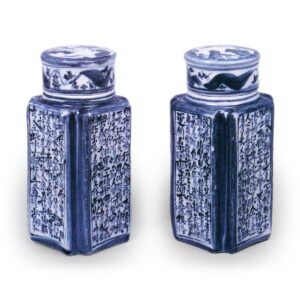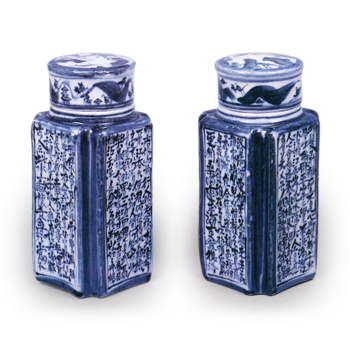
Height 10.8 cm, mouth diameter 3.2 cm, bottom diameter 4.4 x 4.5 cm
Tokyo National Museum
This pair of tea pots, each holding a cup of sencha green tea, is housed in a paulownia wood box with a light-colored painting of the tea ceremony site Uji by Kikumai titled “Rabbit Road, New Greenery. The tea jar is one of Kiime’s finest examples of underglaze blue and is housed in a painted box, making it one of the finest examples of Kiime’s tea ceremony utensils.
This tea jar has a four-sided cylindrical body with a circular mouth and a lid on top, and the four corners of the body have turned corners. The four sides of the lid are decorated with detailed inscriptions of Li Bai’s poem “Pipa Gyo,” and the sides and back of the lid are decorated with landscapes and pavilions. The back of the lid, the joint between the body and the bottom of the body, and the bottom of the body are all in guttural white, and the flat bottom of each pair is engraved with the inscription “Kuji ‘Rin Mokume-zukuri’”.
The lid of the box is marked “White Porcelain Blue Flower Leaf Tea Jar, Isshu” and the side of the box is inscribed with “Rabbit, New Green” and the inscription “Koshin nen natsu aoi satsuri hi onamika tokuchou kun ushirakawa unsui rochu awata toko mokume” with an oval seal “mokume” at the end. It is estimated to have been made in the 7th year of Bunsei Era, at the age of 58.



